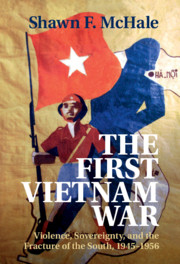Book contents
- The First Vietnam War
- The First Vietnam War
- Copyright page
- Contents
- Figures
- Tables
- Acknowledgments
- Abbreviations
- Introduction: Sovereignty, Violence, and Institutional Collapse at the Edge of France’s Empire
- Part I Fracture, 1945–1947
- 1 A Plural Mekong Delta under Stress
- 2 The Southern General Uprising
- 3 Priming Upheavals in the Mekong Delta
- 4 The Double Fracture of the Mekong Delta
- Part II Disassemblage/Reassemblage, 1947–1953
- Part III Endgame, 1953–1956
- Bibliography
- Index
4 - The Double Fracture of the Mekong Delta
from Part I - Fracture, 1945–1947
Published online by Cambridge University Press: 17 August 2021
- The First Vietnam War
- The First Vietnam War
- Copyright page
- Contents
- Figures
- Tables
- Acknowledgments
- Abbreviations
- Introduction: Sovereignty, Violence, and Institutional Collapse at the Edge of France’s Empire
- Part I Fracture, 1945–1947
- 1 A Plural Mekong Delta under Stress
- 2 The Southern General Uprising
- 3 Priming Upheavals in the Mekong Delta
- 4 The Double Fracture of the Mekong Delta
- Part II Disassemblage/Reassemblage, 1947–1953
- Part III Endgame, 1953–1956
- Bibliography
- Index
Summary
If the struggle in the South began in order to expel the French, violence ended up transforming the countryside, and ripping Mekong Delta society apart. The delta went through two internal fractures at the beginning of the war. The first, dating from late 1945 and into 1946, split many (but not all) Khmer from Vietnamese. The catalyst of this fracture was France's drive into the delta from late 1945, when it recruited "partisans," and especially ethnic Khmer, to fight Viet Minh forces. The French worsened ethnic antagonisms, leading to extensive violence between these two communities. The second major fracture was catalyzed by the Viet Minh's attempt to subdue rivals for leadership of the "nationalist" movement. Primed during 1945 and 1946, this second fracture occurred in 1947. For the second fracture, the chapter looks at two key turning points: Cao Dai leader Pham Cong Tac's decision to tactically ally with the French, and the Viet Minh killing of Hoa Hao Prophet Huynh Phu So. The violence following these two acts reshaped the South and definitively set the course for the rest of the war.
- Type
- Chapter
- Information
- The First Vietnam WarViolence, Sovereignty, and the Fracture of the South, 1945–1956, pp. 94 - 128Publisher: Cambridge University PressPrint publication year: 2021

